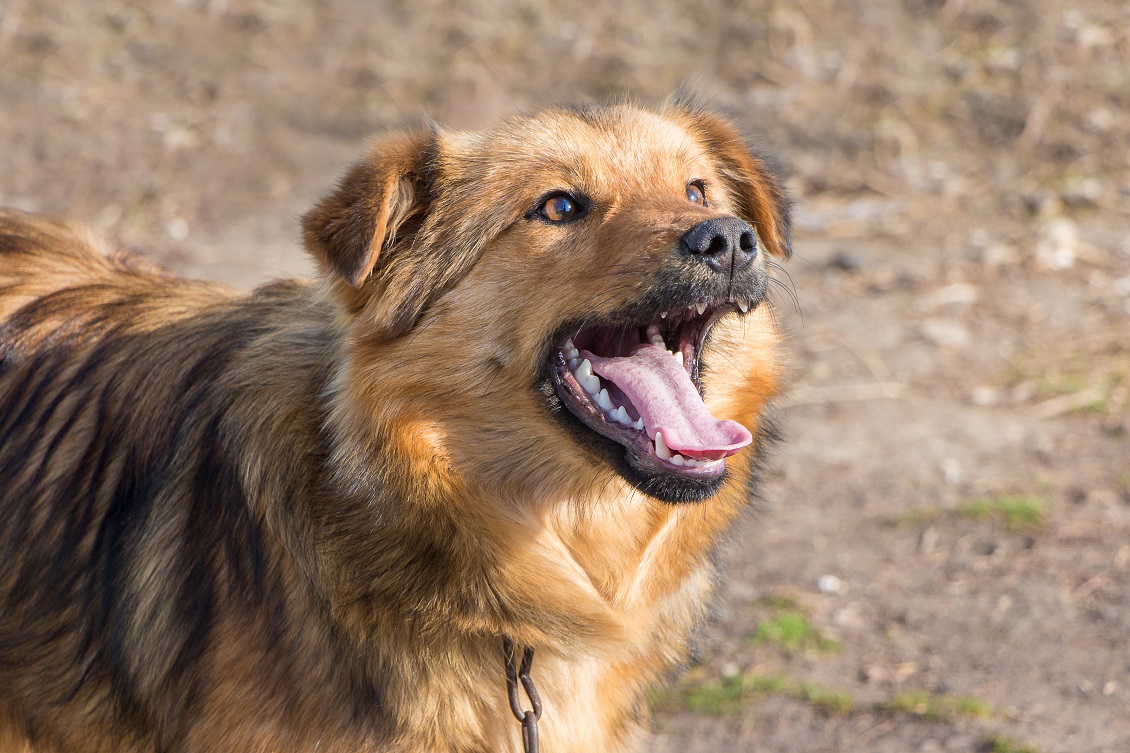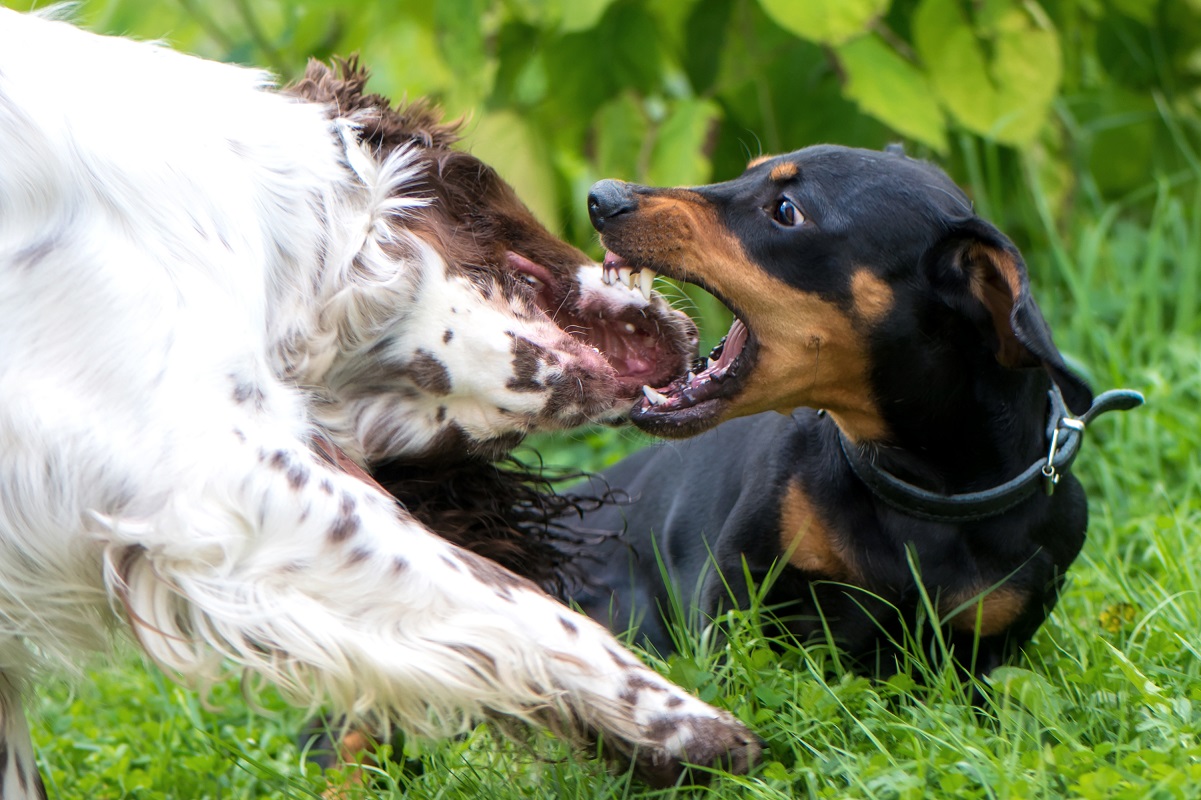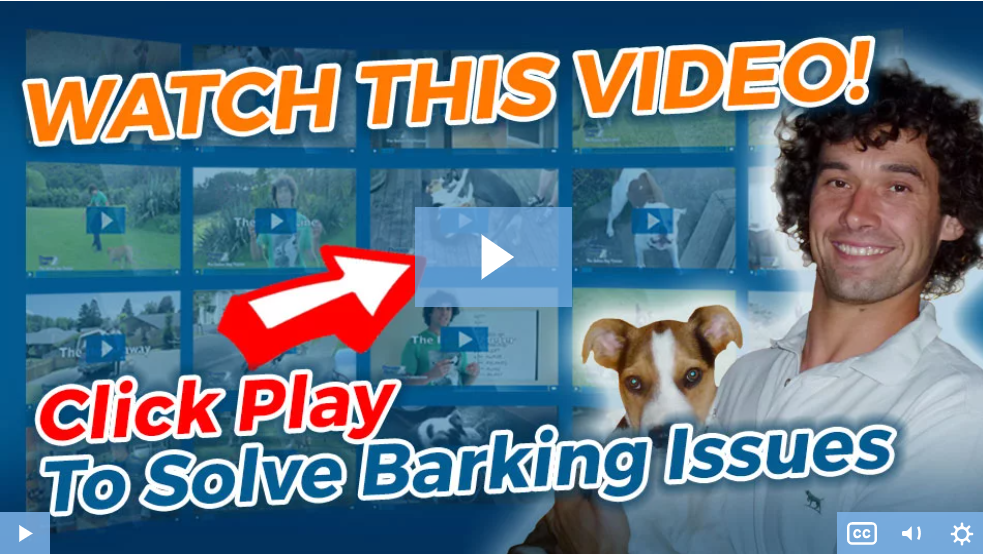Stopping your dog barking at other dogs on walks might seem like an insurmountable problem.
It’s not… It is, on the other hand, a problem you need to get on top of.
Walking a dog who can’t get within sight of another dog without barking isn’t much fun. You know how it is…
You leash up, you fill your pocket with treats, and you head out the door.
You look left, you look right. No dogs. You breathe a sigh of relief. You amble along happily enough for a few minutes, and then suddenly, things take a turn.
The friendly pooch from next door is turning the corner.
You tense up.
Maybe you can turn around before your dog notices. But before you can, your dog’s laser vision narrows in on the newcomer.
And before you know it, all hell breaks loose.
People are staring, your dog is going frantic, and if there was a huge hole going spare, you’d happily jump in it.
It’s embarrassing, it’s stressful, and in some cases, it can be downright painful (if you think pulling on a straining leash is hard for your arm, imagine how it feels for your dog).
Sound familiar?
You’re not alone. It’s a common problem. Thousands upon thousands of dog owners experience the exact same thing.
But for all that, it’s actually not that hard to tackle.
And armed with a basic understanding of how dogs think and a few practical skills, you can dramatically improve your dog’s behavior.
Before we get started, a quick word of advice.
Teaching your dog how to manage their emotions is going to be crucial as you progress. Training them in new behaviors when they’re in a lather of excitement just ain’t gonna work.
So before you do anything else, set yourself up for success by watching these 5 step-by-step calming exercises from the Online Dog Trainer, Dan Abdelnoor (aka, Doggy Dan).
They’re going to calm your dog, focus their attention, and make the training experience way more productive than it would be otherwise.
Here’s the link to take a look: 5-Step-By-Step Calming Exercises
Why Do Dogs Bark?
If you’ve ever wondered what your dog’s thinking, now’s the time to put in the leg work and find out. Because if you can figure out what’s causing your dog to bark in the first place, finding the appropriate fix will be all the easier.
Ultimately, no two dogs are the same. What makes your friend’s dog act the way it does isn’t necessarily going to apply in your case.
That said, there are some common threads that make identifying the cause that much easier.
Take a look at some of the following explanations for excessive barking.
Do any strike a chord?
The Territorial Barker
Some dogs think they have one duty in life: to protect and guard their territory. Controlling exactly who has access to their space and who doesn’t is the only way they’re going to feel safe.
If anyone or anything enters their perceived territory, your dog will work to make sure they know they aren’t welcome.
Cue lunging, snapping, and yep, plenty of barking.
The Dominant Barker
Some dogs like to exercise their control whenever and wherever possible.
They’re the daddy, and they want everyone to know it.
A dominant dog may:
- Refuse your commands
- Growl at you or other family members
- Demand your attention by whining or nudging at you
- Refuse to get out of your way
- Guard their food and toys
And, of course, impose themselves on your eardrums at each and every opportunity.

The Fearful Barker
Some dogs might seem like permanently happy little chappies. But you’d be surprised how many are plagued by fears and anxieties.
If a dog isn’t properly socialized from a young age, they can grow up with all kinds of anxieties around any people, pets, and places that fall outside their limited experience of the world.
Likewise, dogs that have been trained using corrective punishment techniques…
…Been passed around between homes.
Or who’ve suffered some kind of abuse or trauma in their past can quickly and easily develop a fearful nature.
While the problem is unlikely to be limited to just walks, walking on a leash can exacerbate the problem by tapping into the flight or fight response.
If a fearful dog encounters another dog who scares them, their instinct might be to run away. But with the constraint of the leash, they’re forced to resort to the only other option available: fight.
Hence a peacock display of snarling, growling, lunging, and barking… anything, in fact, that’s going to drive the other dog away.
The Frustrated Barker
Some dogs like to walk up to every dog they know (and quite a few, they don’t) and say hello. Most owners, understandably enough, aren’t so keen.
And you know what? That confuses your dog.
When they were a pup, you were probably A-OK with them having a sniff and a lick with the other pups in the park.
So why the sudden change of heart?
If you pull your dog away from every potential new friend they meet on a walk, they’re going to get frustrated. And when they get frustrated, they see absolutely no reason to keep quiet about it.
The Possessive Barker
You’re probably already aware that some dogs like to guard their food and toys.
What you might not be so aware of is that some dogs like to guard their owners, too.
If your dog has got it into their head that your ‘theirs’. They’re not going to be too happy about you letting anyone or anything come too close to you.
If another dog approaches you on a walk, they’re going to make it known in no uncertain terms that you already have an owner.
Related Post: What To Do If Your Dog Barks At Strangers On Walks

How to Stop Your Dog Barking at Other Dogs on Walks
Once you’ve figured out what’s driving your dog’s behavior, you can start tackling the problem by introducing a few simple strategies to your walks.
Remember, no matter what solution you use, keeping your dog calm, centered, and as focused as possible is key.
Work on implementing these 5 step-by-step calming exercises into your routine. By teaching your dog how to take control of their emotions, you’ll be two steps ahead of the game.
Practice Avoidance
Avoiding every other dog for the rest of your life is going to be tricky. But there are certain things you can do to minimize the risk of your dog coming into the path of conflict.
If you can, avoid sidewalks that force your dog to come into head-on contact with other dogs. If your normal route passes by the doggy park or is popular with other dog walkers, change it.
Working to avoid the trigger of your dog’s barking is especially important if their behavior is rooted in fear.
By putting them into a situation where they feel compelled to react in a certain way, you can unintentionally reinforce their behavior.
Think about it…
Your dog barks at another dog in an attempt to get it to go away. You beat a hasty retreat and bingo! The other dog is gone.
And your own dog learns that barking is a sure-fire way of getting them what they want.
Good luck with replacing their response with a more positive one while that’s in their head…
Mix Things Up
Does every walk follow the same pattern? If it does, start mixing things up.
Add in a few new routes, circle back on yourself, go through obstacles, add in a few jogs – basically, do whatever it takes to keep your dog guessing.
If they’re focusing their attention on you to see what you’re going to do next, they’re less likely to notice any other dogs.

Respect their Threshold
Regardless of what technique you’re utilizing to manage your dog’s behavior, avoid anything that pushes them over their comfort threshold.
Some dogs might be able to get within a few feet of another dog before they start barking. Others might only need to catch a glimpse of a dog on the horizon to get worked up.
Whatever their threshold is, respect it.
Getting too close to another dog will only serve to arouse them. Once that happens, teaching them any form of new behavior is just not going to happen.
Dial Down the Excitement
If your dog starts each walk in a ramped-up state, you’re not going to get too far before the barking starts.
Dial things down a notch.
Avoid working them up into a state by clapping your hands and shouting ‘walkies’ before heading out.
If they seem excited, pop their leash on before finding something else to do for a few minutes. Once they’re lost all thought of going for a walk, head out.
This is also the perfect time to knuckle down and practice those 5 step-by-step calming exercises I introduced you to earlier.
Socialize your Dog
If your dog has never been socialized properly, it’s time to start.
Try signing them up for a dog obedience class.
As they’ll be focused on learning commands, they’ll be too distracted to see the other dogs in the class as a potential threat.
Let the trainer know about the issue so they can work on slowly and safely introducing your dog to other dogs in the class.
If your dog has never been socialized with people, an obedience class is also a great place to encourage interaction.
Related Post: How To Socialize An Aggressive Dog – A Step By Step Guide

Adjust Their Thinking
If your dog has developed negative associations about other dogs, it’s time to replace that negativity with some positivity.
Next time you’re heading out for a walk, load up on plenty of small, high-value treats.
During the walk, reward your dog with a verbal marker like ‘Good’ followed by a treat each time they check in with you/ look up at you.
Carry on practicing the routine on every walk for the next week.
If the reward is high value enough, they should be checking in with you between 30 and 50 times per 15-minute walk by the end of the week.
For week 2, you’ll need to find a quiet spot where you can watch dogs from a distance where your dog won’t bark. For most dogs, this will be around 20 to 30 feet.
Over the next 7 days, park yourself at that same spot for 5 to 10 minutes.
Whenever you see another dog approach, don’t cue your dog or react in any way.
If last week’s training has worked, your dog will check in with you automatically.
When they do, mark and reward the behavior before continuing the waiting game.
In week three, resume your normal walks. If the previous 2 weeks have gone to plan, your dog will be more inclined to check in with you when they see another dog than they will be to bark.
You’re not going to see perfection straight away. But over time, you should notice a continued improvement in your dog’s behavior.
Stay Calm
If you’ve been dealing with excessive barking for a while now, it’s likely that the sight of approaching dogs is triggering you as much as it is your dog.
The problem is, anxiety is contagious. If your dog feels your tension traveling down the leash, it’s going to exacerbate their own tensions and fears.
Stay calm.
Avoid jerking or shortening your dog’s leash when you see another dog. Doing either will simply encourage your dog to think that other dogs are a threat or something to be feared.
Keeping calm will help your dog do the same.
Final Thoughts
Teaching a dog a new set of behaviors is rarely something that happens overnight.
Don’t expect your dog to suddenly quit barking immediately – it’s not going to happen.
But that doesn’t mean it won’t eventually.
Regardless of what training technique you utilize, remember to keep patient, keep consistent, and keep it positive.
With time and effort, very few problems can’t be managed.

